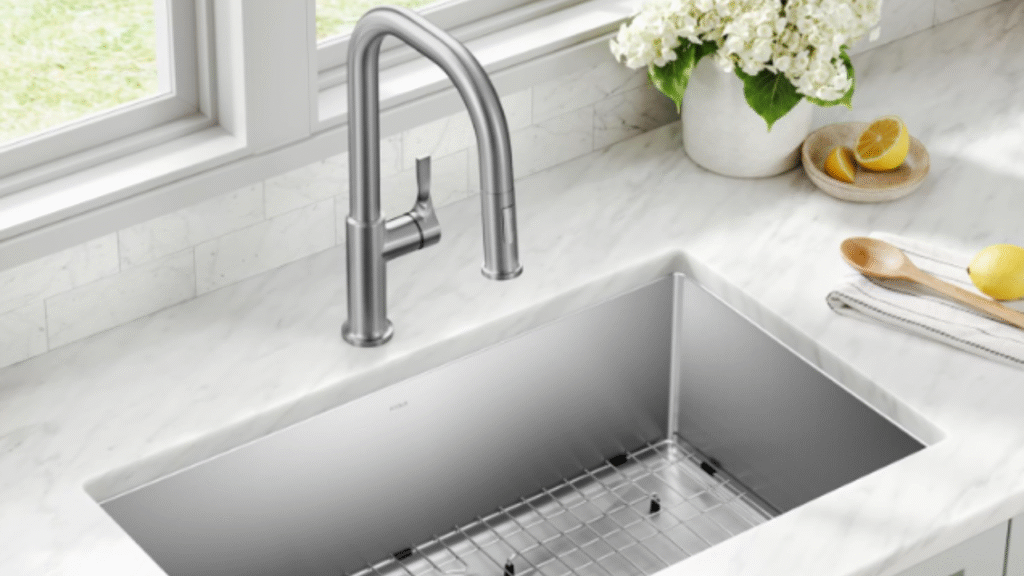
Choosing a new kitchen sink isn’t just about picking a basin; it’s about defining the workflow, aesthetics, and long-term functionality of your kitchen, which is truly the workhorse of your entire home. The sink is a critical component for food prep, cleaning, and sometimes even entertaining. With numerous materials, mounting styles, and configurations available today, understanding the differences between the major Kitchen Sink Types is essential for making a successful and lasting choice.
The choice isn’t just visual; it significantly impacts how you use your countertops, how easily you clean up, and how much you pay for installation. Sinks generally consist of three main components: the basin (or bowl), the faucet, and the drain. The fundamental differences often hinge on material and mounting style, which drastically affect function and cost. Whether you prioritize seamless counter cleanup or a lower installation bill often dictates which of the major Kitchen Sink Types you select.
The Great Debate: Undermount vs. Drop-in (Mounting Style)
The mounting style determines how the sink interacts with your countertop, affecting aesthetics and cleaning efficiency.
Undermount Sinks (The Sleek Choice)
Undermount sinks are installed from underneath the countertop, attaching to the underside with special clips and sealed with silicone caulk.
- Aesthetics: They provide a sleek, seamless, and modern look, often associated with custom, high-end designer kitchens.
- Function: They are the clear winner for counter cleaning because the lack of a rim allows you to swipe food particles and debris directly off the counter and into the basin. This configuration also maximizes available counter real estate.
- Drawbacks: They are typically more expensive to install because they require precise fitting, careful bonding, and often a polished cut-out in stone countertops (like quartz or granite), which is costly (in the UK, stone cut-outs run about £118–£185 per cut). Additionally, the crevice where the sink meets the counter can accumulate food buildup, sometimes necessitating the caulk to be removed and replaced every three to five years.
Drop-in (Top-Mount) Sinks (The Practical Choice)
Drop-in sinks (also called self-rimming) sit in a hole cut into the counter, with a rim or lip resting on top of the surface.
- Aesthetics: This style features a visible perimeter lip, which can suit a traditional or old-fashioned, quaint look.
- Installation & Cost: They are the least expensive to install, often making installation a viable DIY project. Crucially, they are compatible with all countertop materials, including laminate, which is inexpensive to cut (as little as ~£40 per cut in the UK).
- Function: Drop-in sinks win the “sink cleaning” category, as all working areas are visible and accessible.
- Drawbacks: The lip is an obstruction that collects dirt and grime, meaning you have to swipe debris around the rim instead of over it.
| Comparison Factor | Undermount Sink | Drop-in Sink |
|---|---|---|
| Aesthetic | Sleek, seamless, modern, custom | Traditional, old-fashioned, visible rim |
| Counter Cleaning | Win (Debris can be swiped directly into the sink) | Loss (Rim collects gunk and must be swiped around) |
| Installation Cost | Higher (Requires precision and expensive stone cutting) | Lower (Easy to install, compatible with inexpensive laminate) |
| Counter Compatibility | Best with granite, quartz, stone (problematic with MDF/laminate) | Works with all materials, including laminate and tile |
Large and Lovely: Apron and Farmhouse Sinks
The classic farmhouse design represents one of the most beloved Kitchen Sink Types. While “apron” and “farmhouse” sinks are often used interchangeably, there are subtle differences. An apron-front sink, as the name suggests, has an exposed front that extends beyond the cabinet housing.
Why Choose a Large Sink?
- Capacity: They are typically wider and deeper than conventional sinks, which is highly beneficial for meal prepping, cleaning large pots and bakeware, or handling cleanup after a big dinner party.
- Ergonomics: The exposed apron reduces the counter space you have to reach over, which can help alleviate awkward bending or hunching when washing dishes.
- Protection: The apron front helps protect your cabinetry by directing water splashes straight to the floor, acting “much like an umbrella”.
Material and Cost
Traditional farmhouse sinks are usually fireclay or cast iron, contributing to their distinctive, quaint, and homey look. Contemporary apron sinks are available in materials ranging from stainless steel to copper and engineered stone.
- Cost: Both farmhouse and apron sinks tend to be more expensive than average kitchen sinks.
- Installation: Installation fees are often higher because they require counter-cutting and modification of existing cabinetry. Also, the size and material often make them heavier, requiring you to ensure your base cabinets can support the weight.
The Supporting Cast: Prep and Pantry Sinks
For large kitchen builds or remodels, clients often opt for two sinks to improve workflow and organization. Considering secondary kitchen sinks (like prep or pantry sinks) can drastically change how you use your main area.
A kitchen sink is the heart of the home, used for major cleanup and food preparation, typically ranging from 22–36 inches in length, often with multiple bowls.
A pantry sink (or prep sink) is a secondary sink.
- Size: Pantry sinks are generally smaller (15–20 inches in length) and often feature a single bowl configuration.
- Function: Prep sinks are placed near the food preparation area to save the cook from carrying items back and forth to the main sink. They are designed for specific tasks like handwashing, rinsing vegetables, or filling water bottles.
- Workflow: If multiple people are cooking or if you entertain often, a secondary sink eliminates congestion at the main sink, making the process more efficient.
- Aesthetics: Since they get less heavy use, you can choose a sink for its beauty or artistic value, making it different from the main, function-focused sink.
- Cost: Installation for a secondary pantry sink ($100–$500) is generally cheaper than for a main kitchen sink ($200–$1,000).
One user might joke: “We put a prep sink on the island and now my husband can chop veggies without spilling kale juice all over the countertop, which is a major victory for our marriage.”
Material Matters: Durability, Aesthetics, and Price
The material choice determines the sink’s aesthetic, its resilience, and its overall supply cost.
| Material | Aesthetics/Style | Durability & Maintenance | Typical UK Supply Cost |
|---|---|---|---|
| Stainless Steel | Sleek, modern, transitional | Durable, resistant to scratches/corrosion, easy to clean, but can be noisy | Starts from £100 |
| Fireclay/Ceramic | Classic, quaint, traditional, homey | Highly durable against impact, non-porous, easy to clean with soapy water, but harsh chemicals can permanently stain | Often £210–£1,090+ |
| Granite Composite | Aesthetic appeal, natural look | Heat resistant, durable, may require occasional sealing | From ~£190 – £1,000 |
| Copper | Rustic, high-end, striking hue | Durable, but delicate; sensitive to acidic foods and abrasive items; can dent easily | Among the most expensive |
Amazon Kitchen Sink Reviews
Based on the characteristics described in the sources, here are five simulated product suggestions spanning various styles and materials:
1. The Seamless Solution: 30-Inch Undermount Stainless Steel Sink
Please enter product(-s) ASIN(-s)!- Type: Undermount, Stainless Steel
- Review: This is the ideal sink for modern kitchens, focusing on minimal style. Installation requires precision and is more costly than a drop-in, but the ease of wiping food scraps directly off a quartz or granite counter and into the bowl makes it worth the investment. It’s extremely durable and resistant to corrosion. Note: Be ready for the extra work and cost of maintaining that caulk seal where it meets the counter.
2. The Centerpiece: White Fireclay Farmhouse Apron Sink
- Type: Farmhouse/Apron Front, Fireclay
- Review: If you want a striking focal point, the fireclay apron style is perfect for a country or provincial look. The large capacity is fantastic for washing those huge holiday roasting pans or filling large containers. Fireclay is durable against impact and easy to clean with just soapy water. Just remember that installation is challenging—you’ll likely need cabinet modifications and a strong base cabinet to support the weight.
3. The Workhorse: Dual-Bowl Granite Composite Drop-In
- Type: Drop-in/Top-Mount, Granite Composite
- Review: This sink is a great compromise between aesthetics and budget. Granite composite offers durability and heat resistance, while the drop-in mounting style is compatible with budget-friendly laminate countertops and is the least expensive to install. The dual-bowl configuration allows for simultaneous tasks, like washing dishes in one bowl and draining in the other.
4. The Artistic Touch: Hammered Copper Bar/Prep Sink
- Type: Prep/Bar Sink, Copper, Undermount
- Review: This is a beautiful secondary sink option for an island or bar area, providing an artistic, high-end, rustic feel. Its smaller size (15–20 inches) is perfect for rinsing glasses or prepping cocktails. Copper also has natural antimicrobial properties. Buyer beware: It is among the most expensive types, and you must be gentle—acidic foods or harsh cleaners can damage the patina.
5. The Designer Dream: Flush Mount Stainless Steel Sink
- Type: Flush Mount, Stainless Steel
- Review: The flush mount option offers the seamless aesthetic of an undermount but cleverly avoids the crevice cleaning issues, as there is no gap between the sink and the countertop. This high-end solution is generally recommended for transitional or modern kitchens. Be warned, this is the most challenging installation type, requiring extreme installer skill and precision, making it one of the most expensive procedures overall.
Final Thoughts: Choosing the Right Sink for Your Lifestyle
Selecting the perfect Kitchen Sink Type requires weighing function, budget, and design aspirations. Whether you need a massive basin for a family cleanup zone or a small, artistic prep sink for entertaining, there is a configuration tailored to your lifestyle.
These various kitchen sink types each offer unique advantages, from the easy installation and budget-friendliness of a drop-in sink to the sleek, high-value appearance of an undermount sink. If you host large parties or have multiple cooks, consider a large farmhouse sink or incorporating a secondary prep sink to optimize your workflow. Investing in the right Kitchen Sink Type ensures efficiency, organization, and aesthetic satisfaction for years to come. Don’t settle for a sink that causes “clogs and bad pipes” or a strainer basket that is “so gross.”, Choose a sink that supports your culinary habits and simplifies your cleaning routine!
Frequently Asked Questions (FAQs)
What is the primary difference between a pantry sink and a main kitchen sink?
A main kitchen sink is large and versatile (22–36 inches), used for washing dishes and major meal preparation. A pantry sink is typically smaller (15–20 inches, single bowl) and is designed for specific, secondary tasks like handwashing or vegetable rinsing to improve overall kitchen workflow.
How does the installation cost of an undermount sink compare to a drop-in sink?
Drop-in sinks are typically the least expensive to install and can be a DIY project. Undermount sinks are more expensive to install because they require precise fitting, special clips, and costly polished cuts in stone countertops.
Are traditional drop-in sinks out of style?
While undermount sinks have become very popular due to their sleek, seamless look, drop-in sinks are still practical, budget-friendly, and versatile, working with any countertop material. They maintain a popular traditional or quaint style in many kitchens.
What is “crazing” in fireclay sinks?
Crazing is a potential downside of cheaper fireclay sinks, where the clay absorbs moisture over time, causing gray lines to appear under the surface. Higher-priced, quality fireclay products are less susceptible to this issue.
Is copper a good material for a kitchen sink?
Copper is durable and provides a striking, high-end aesthetic, along with natural antimicrobial properties. However, it is delicate and highly sensitive to damage from acidic foods, abrasive items, and harsh chemicals, which can ruin its patina. It is also one of the most expensive sink materials.
